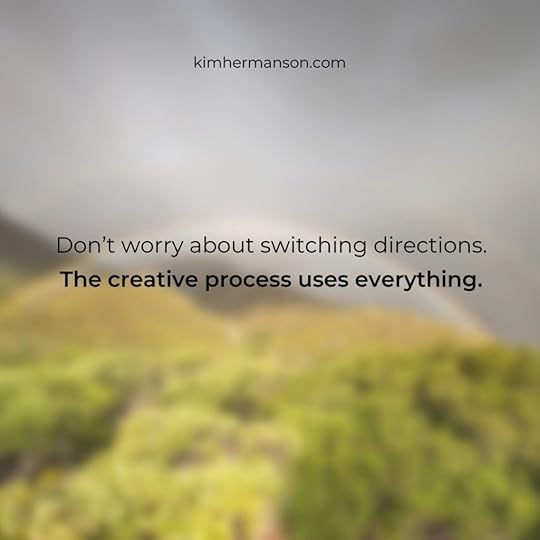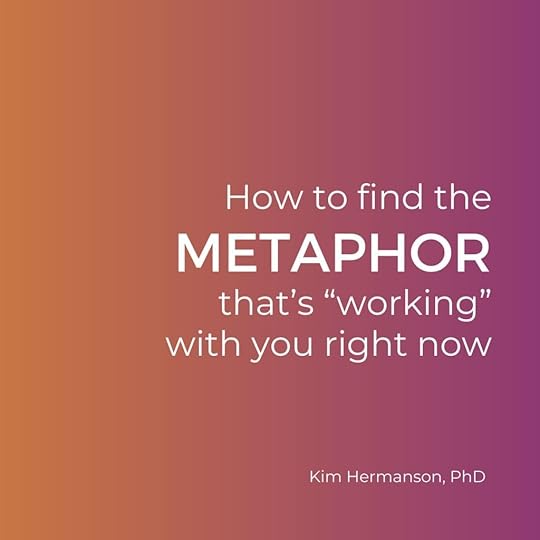Kim Hermanson's Blog, page 21
February 1, 2022
Why it’s OK to switch directions.

A creative life is not linear.
It has twists and turns.
But that doesn’t mean those pieces and experiences don’t come back around.
In my twenties, I worked as a computer scientist for two Fortune 500 companies.
At the age of 27, I broke my back in a head-on collision on the highway and was given less than 5% chance of walking again.
After a year of recovery, I entered the PhD program at the University of Chicago to study adult learning.
While there, I co-authored an article and two book chapters with Mihaly Csikszentmihalyi and received an award for my research.
When I finished the PhD, I moved to the backwoods of Montana to hang out with a bunch of hippies. (By the way, I wouldn’t trade those years for anything.)
The Spanish word aprovechar means to make good use of whatever you have at your disposal.
That’s what we do when we’re creative.
Don’t worry about switching directions. The creative process uses EVERYTHING. 
When have YOU switched directions?
The creative process uses everything.

A creative life is not linear.
It has twists and turns.
But that doesn’t mean those pieces and experiences don’t come back around.
In my twenties, I worked as a computer scientist for two Fortune 500 companies.
At the age of 27, I broke my back in a head-on collision on the highway and was given less than 5% chance of walking again.
After a year of recovery, I entered the PhD program at the University of Chicago to study adult learning.
While there, I co-authored an article and two book chapters with Mihaly Csikszentmihalyi and received an award for my research.
When I finished the PhD, I moved to the backwoods of Montana to hang out with a bunch of hippies. (By the way, I wouldn’t trade those years for anything.)
The Spanish word aprovechar means to make good use of whatever you have at your disposal.
That’s what we do when we’re creative.
Don’t worry about switching directions. The creative process uses EVERYTHING. 
When have YOU switched directions?
In an impossible conflict, find the third space.

When you’re in a no-win situation… for example, you’re in the middle of a disagreement between your husband and daughter. Or your clients are demanding one thing and your boss something different, there actually IS a solution.
You can shift into third space.
Third space is a place we don’t know exists until we’re faced with a situation where we need to move and there’s no rational place to move TO.
Our deepest conflicts in life are an opportunity to find the creative response—the “third space” that embraces the opposing sides and offers an entirely fresh solution or perspective.
The creative process loves this challenge. After all, the deep creative wants to move…in the most expansive, life-giving way.
For more on finding third space when you teach, train, coach or facilitate: https://www.kimhermanson.com/2017/10/01/creating-third-space-when-you-teach-train-coach-or-mentor-2/
The deep creative wants to move in the most expansive, life-giving way.

When you’re in a no-win situation… for example, you’re in the middle of a disagreement between your husband and daughter. Or your clients are demanding one thing and your boss something different, there actually IS a solution.
You can shift into third space.
Third space is a place we don’t know exists until we’re faced with a situation where we need to move and there’s no rational place to move TO.
Our deepest conflicts in life are an opportunity to find the creative response—the “third space” that embraces the opposing sides and offers an entirely fresh solution or perspective.
The creative process loves this challenge. After all, the deep creative wants to move…in the most expansive, life-giving way.
For more on finding third space when you teach, train, coach or facilitate: https://www.kimhermanson.com/2017/10/01/creating-third-space-when-you-teach-train-coach-or-mentor-2/
How to find the metaphor that’s working you.

How to find the metaphor that’s “working” you right now:
a. Spend time in nature (or a city park). Whatever stands out to you will be a metaphor.
b. Notice the metaphors that show up in your conversations.
c. Close your eyes, take a deep breath and then open your eyes. What is the first thing you see? What quality do you notice about it? That’s a metaphor.
d. How are you feeling right now? If you were going to give that feeling an image, what would it be? Fire? Cloud? A heavy piece of industrial equipment?
e. Ask a friend for whatever image spontaneously pops into his or her head. What quality does the image have? That’s your metaphor.
How to find the metaphor that’s “working” you right now

How to find the metaphor that’s “working” you right now:
a. Spend time in nature (or a city park). Whatever stands out to you will be a metaphor.
b. Notice the metaphors that show up in your conversations.
c. Close your eyes, take a deep breath and then open your eyes. What is the first thing you see? What quality do you notice about it? That’s a metaphor.
d. How are you feeling right now? If you were going to give that feeling an image, what would it be? Fire? Cloud? A heavy piece of industrial equipment?
e. Ask a friend for whatever image spontaneously pops into his or her head. What quality does the image have? That’s your metaphor.
Breakthroughs happen when we see what lies outside our ordinary sight.

As a coach and educator, my work is to reveal the wisdom that lies in the spaces we can’t see.
Creative breakthroughs happen when we perceive the wisdom that lies outside of our ordinary ways of looking.
In Gestalt psychology, there is a concept called ‘figure’ and ‘ground.’ Westerners tend to see figure and we have a harder time seeing ground. For example, looking at a fish tank, a Westerner will immediately notice the biggest or prettiest fish, and not the broader environment—sand, seaweed, etc.
What would happen if you shifted your looking?
Just because you can’t see it, doesn’t mean it isn’t there.
Creative breakthroughs happen when we perceive the wisdom that lies outside of our ordinary ways of looking.

As a coach and educator, my work is to reveal the wisdom that lies in the spaces we can’t see.
Creative breakthroughs happen when we perceive the wisdom that lies outside of our ordinary ways of looking.
In Gestalt psychology, there is a concept called ‘figure’ and ‘ground.’ Westerners tend to see figure and we have a harder time seeing ground. For example, looking at a fish tank, a Westerner will immediately notice the biggest or prettiest fish, and not the broader environment—sand, seaweed, etc.
What would happen if you shifted your looking?
Just because you can’t see it, doesn’t mean it isn’t there.
To connect with yourself in a deeper way, be smaller.

Sometimes we need to be smaller in the world…so we can connect with ourselves in a deeper way.
What does being smaller mean for you?
Smaller may mean understanding that you can’t help everyone.
For my client who’s going through a messy tax situation with her ex-husband, it means stepping back and letting things work themselves out without getting involved.
For my client who’s launching a new program, it means cutting a 12-hour seminar down to three hours. Three hours feels manageable and less overwhelming.
Where do you need to be small right now? 
What does being smaller mean for you?

Sometimes we need to be smaller in the world…so we can connect with ourselves in a deeper way.
What does being smaller mean for you?
Smaller may mean understanding that you can’t help everyone.
For my client who’s going through a messy tax situation with her ex-husband, it means stepping back and letting things work themselves out without getting involved.
For my client who’s launching a new program, it means cutting a 12-hour seminar down to three hours. Three hours feels manageable and less overwhelming.
Where do you need to be small right now? 



